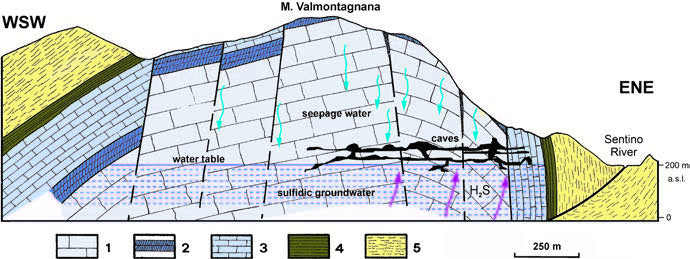Groundwater dilution and flow conditions in sulfuric acid caves: the case study of Frasassi (Italy)
DOI:
https://doi.org/10.3986/ac.v52i2-3.13149Keywords:
sulfuric acid speleogenesis, hypogenic caves, sulfidic groundwater, Frasassi Caves, Central ApenninesAbstract
This study analyzes the dilution process of the sulfidic groundwater in the Frasassi caves due to the recharge of O2-rich freshwater and its influence on the sulfuric acid speleogenesis and morphogenesis. The drainage pattern and the seasonal changes of the chemo-physical characteristics of the groundwater through a year-long monitoring and the measurements of the groundwater levels are presented. The inflow of water infiltrating from the karst surface influenced the sulfidic groundwater parameters, reflecting the seasonal meteoric cycle. On the contrary, the Sentino River, which represents the local base level, directly influenced the groundwater only in the most external part of the cave. The water level measurements evidenced a low hydraulic gradient (~3‰), due to the high karstification, and also some differences in the permeability depending on the drainage direction. Most cave pools are isolated on the surface and connected to each other through a network of submerged passages. In the present conditions, a surface layer of bicarbonate water forms above the sulfidic water in a large part of the cave, where it impedes subaerial corrosion by released acidic gases. Conversely, the distribution of residual gypsum deposits and corrosional wall features in the upper old cave levels demonstrate that large interfaces between sulfidic water and cave atmosphere existed during some periods of the cave history. Here, the release of acidic gases (CO2 and H2S) and the production of H2SO4 from H2S oxidation caused the widespread subaerial corrosion which significantly contributed to the morphogenesis. The comparison between these residual morphologies and the active processes shows that morphogenesis in the cave has evolved through time, influenced by hydrodynamic conditions, in turn depending on the general morphological and hydrogeological setting of the whole karst area.
Downloads

Downloads
Published
How to Cite
Issue
Section
License

This work is licensed under a Creative Commons Attribution 4.0 International License.
Authors guarantee that the work is their own original creation and does not infringe any statutory or common-law copyright or any proprietary right of any third party. In case of claims by third parties, authors commit their self to defend the interests of the publisher, and shall cover any potential costs.
More in: Submission chapter




